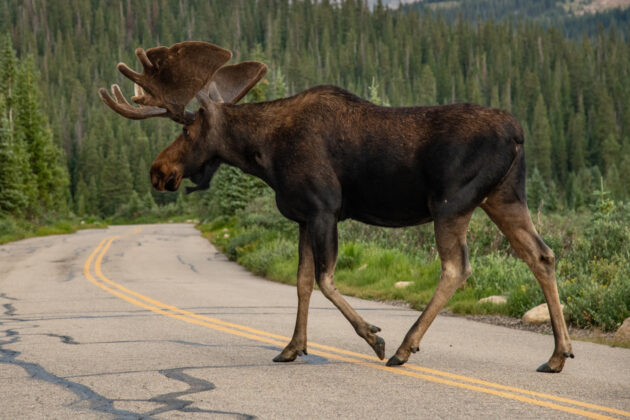Dash cams complement – but don’t replace – the human element
Dash cams don’t lie. But dash cams also don’t tell the whole truth.
Eyesight is better than a dash cam, however, eyesight isn’t always translated properly to the memory.
It’s easy to take one absolute statement and believe that as the only way to be. Just look at our political climate these days.
So, are dash cams all good? No, they aren’t, but they’re a great tool.
Something I’ve learned from using a dash cam for the last several years is that our memory is often faulty. This came to mind again recently as I was rolling southbound along Hwy. 17 near Wawa, Ont. I had a run-in with a moose and an OPP officer asked me how big it was.
Seems like a simple question, right? Not really. Insert fisherman’s joke of the one that got away. Memory is shaped by what we’re inclined to prove, or based on our reaction to an event. Our memory will also block out things that it deems to be too traumatic.
In this case for me, the memory of the moose loomed large in my mind. Appearing larger than it really is gives us that burst of adrenaline to escape the situation. It’s the caveman’s “fight-or-flight” instinct that’s kept us alive through millennia.
I’ve had other situations like this. Someone says “You were speeding!” and you show the video proving you were actually under the limit. They saw a big, scary truck and their memory was of a runaway unit. After seeing the video, the reaction is usually surprise that their memory was wrong.
This difference between memory and video has been very intriguing to me.

If the video is so much clearer than memory, do we even need written statements from the driver after an incident, or can we base everything off the video?
While the memory isn’t always clear on some details, the driver has a better, and faster ‘computer’ than any dash cam. That is, if the driver is paying attention.
A driver has the best vision when all things are considered. In the case of the moose, I saw it before it was visible on the video and I started reacting. It was at night and while my dash cam is pretty decent, it’s not as good as my eyes. Sure, infrared and radar in the better systems help, but nothing is infallible. The number of variables that the human brain can process is truly incredible. Is something a threat, or will it be ok?
Does the disappearance of the lines on the road mean the road conditions are changing? Or have they just not been repainted yet? Is there another vehicle around that corner that you need to react to because your eyes see a potential danger?
Having said all that, I love that technology is improving and we need to embrace it. My goal is to reduce danger, not to replace the driver…yet. How many years have we had autopilot in airplanes, yet we still have pilots?
So, getting back to video versus driver. We need both. Video will remember some things more accurately and the driver can fill in the blanks on what’s not captured.
Here’s something else that’s fascinating to me: the driver has one chance to get it right. At 100 km/h they’re travelling 27.8 meters per second! The range of low beam lights is about 40 meters and the high beams are about 100 meters. In the best-case scenario at night a driver has less than four seconds to react – total. Human reaction time is three-quarters of a second. Now you’re three seconds, or 75 meters away. You have 75 meters to brake, avoid, accelerate – whatever your brain has decided you should do.
When we replay the video, what do we do? I know what I do on my Crazy Canuck Truckin YouTube channel. I slow it down, replay it, highlight areas, say “look for this,” etc. Why? Because it’s so hard to grasp everything that’s going on. The driver has just one chance. The human brain is incredible under stress.
Keep this in mind when reviewing dash cam footage.
That moose? Bigger than any deer, but not a full-grown moose. It still ran away.
Have your say
This is a moderated forum. Comments will no longer be published unless they are accompanied by a first and last name and a verifiable email address. (Today's Trucking will not publish or share the email address.) Profane language and content deemed to be libelous, racist, or threatening in nature will not be published under any circumstances.
Love the podcast David you and size matters do a great job.
To respond to Joseph Sullivan that inward facing camera is called a colonoscopy and
Only 30mins once a year.
We need the camera and we need the eyes! I agree . Two of us in a tractor trailer traveling slowly anticipated and watched a left turn collision. A small car passed us , then proceeded to turn left in front of another car headed straight through in the daylight.
Both cars had hardly stopped moving when I turned my head to my co driver to ask which car was westbound and which was east bound. He looked back at the wrecks. Then he looked at me and shrugged his shoulders.
To be fair , both cars were dark , 4 door sedans , but two “eye witnesses “ would be unqualified to witness at the trial.
Dash cams are good, but without inward facing camera you do not know what the driver was doing prior to the reaction recorded on the outward cam.
As stated driver memory is never 100% and the more severe the trauma, the greater impact on driver recall.
Good discussion..